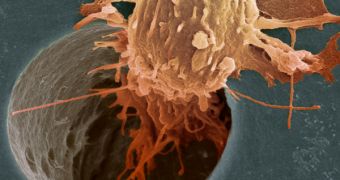Researchers at the US National Cancer Institute, led by Dr. Hisataka Kobayashi, managed to devise a compound that can virtually 'light up' cancerous cells, rendering them visible, and, thus, traceable. The find has enormous application potentials, given the fact that the evolution of various types of cancer can now be traced thoroughly inside a patient's body. This will eliminate previous risks associated with surgeries, when doctors could always miss a part of the tumor, which was hidden somewhere else in the body.
"These compounds may allow clinicians to monitor a patient's response to cancer therapy by allowing them to visualize whether a drug hits its target and whether hitting the target leads to shrinkage of the tumor," argues Dr. Kobayashi.
"Unlike other activatable fluorescent compounds, our compound consists of a targeting agent and a fluorescing agent that act independently. We can target the fluorescing agent to different types of cancer cells by using any antibody or molecule that is internalized by the targeted cells after it binds to the cell's surface proteins."
Already, he and his colleague, Yasuteru Urano from the University of Tokyo, managed to trace the light signature cancerous cells left behind in living mice, using an endoscope, which is a very small camera that can be maneuvered inside a patient's body. They've only managed to track down ovarian and breast cancer cells, although, in theory, it's possible to follow any kind of cells.
The interesting fact is that, once the luminescent cells are killed, the glow seizes after about half an hour, which could be used as a clear indicator as to whether the tumor is actually entirely gone, or if there are still remnants tucked away in hidden places.
"Our design concept is very versatile and can be used to detect many types of cancer," says Dr. Kobayashi, because it only attaches to living cells, giving doctors the possibility to track them in real time. This helps them determine the size of the tumor, or if there's even gonna be a tumor. All these data will be invaluable in assessing a correct course of treatment for each patient.

 14 DAY TRIAL //
14 DAY TRIAL //